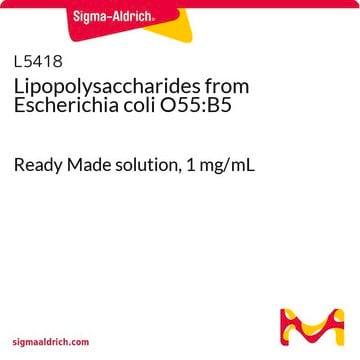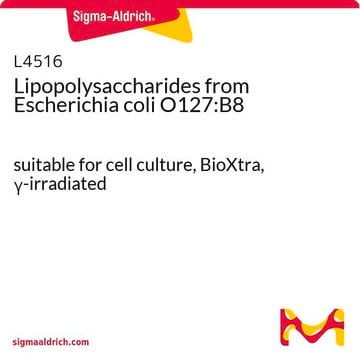L2880
Lipopolysaccharides from Escherichia coli O55:B5
purified by phenol extraction
Sinónimos:
LPS
About This Item
Productos recomendados
biological source
Escherichia coli (O55:B5)
Quality Level
form
lyophilized powder
purified by
phenol extraction
technique(s)
cell based assay: suitable
impurities
<3% Protein (Lowry)
color
off-white to tan
solubility
water: soluble
application(s)
cell analysis
clinical research
life science and biopharma
shipped in
ambient
storage temp.
2-8°C
¿Está buscando productos similares? Visita Guía de comparación de productos
Categorías relacionadas
General description
Application
- to stimulate hepatocytes and non-parenchymal cells
- to stimulate the spleen and study the expression of the Malitaf gene in the fish blunt snout bream
- as part of the concanavalin A (ConA) and D-galactosamine/lipopolysaccharide (D-GalN/LPS) model of fulminant hepatitis to study the effect of the natural compound hesperetin
- to check the cell viability of human chorionic villi-derived mesenchymal stem cells (hCMSCs) by methyl thiazolyl tetrazolium (MTT) assay
- to induce oligodendrocyte toxicity to evaluate the neuroprotective effects of few compounds
- to induce sarcopenia in rats to evaluate the antioxidant effects of curcumin-loaded hydrophobic surface-modified hydroxyapatite
Biochem/physiol Actions
Other Notes
related product
signalword
Danger
hcodes
Hazard Classifications
Acute Tox. 2 Oral
Storage Class
6.1A - Combustible acute toxic Cat. 1 and 2 / very toxic hazardous materials
wgk_germany
WGK 3
flash_point_f
Not applicable
flash_point_c
Not applicable
ppe
Eyeshields, Gloves, type N95 (US)
Certificados de análisis (COA)
Busque Certificados de análisis (COA) introduciendo el número de lote del producto. Los números de lote se encuentran en la etiqueta del producto después de las palabras «Lot» o «Batch»
¿Ya tiene este producto?
Encuentre la documentación para los productos que ha comprado recientemente en la Biblioteca de documentos.
Los clientes también vieron
Artículos
Explore the structure, function, and diverse applications of Lipopolysaccharides. Discover their role in bacteria, serological specificity, and research potential.
Nuestro equipo de científicos tiene experiencia en todas las áreas de investigación: Ciencias de la vida, Ciencia de los materiales, Síntesis química, Cromatografía, Analítica y muchas otras.
Póngase en contacto con el Servicio técnico




